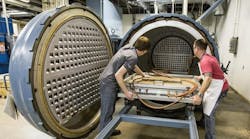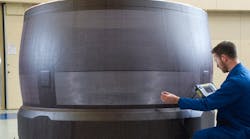GE Aviation plans to build a new manufacturing plant in Asheville, N.C., to produce ceramic matrix composites for high-pressure turbine components. The $125-million, advanced manufacturing plant will manufacture stationary parts for LEAP turbofan engines produced by CFM International, a joint venture of GE Aviation and Snecma, a French aircraft engine manufacturer.
Other critical parts may be produced, too. GE research engineers have been developing ceramic matrix composite materials, or CMCs, since the 1990s. They also designed specialty machines for producing the materials.
That process will continue to be carried out at GE’s high-tech ceramics laboratory in Newark, Del., where much of the development on CMCs has been carried out.
“We are pushing ahead in materials technology, which gives us the ability to make jet engines lighter, run them hotter, and cool them less,” according to Michael Kauffman, a GE Aviation manufacturing executive.
CMCs reportedly weigh about one-third as much as most standard cast metal alloys used in aircraft turbines, and could have various applications, like turbine blades, rotors, and other parts.
The 125,000 square-foot plant is to be built adjacent to a GE Aviation machining operation in Asheville, and could be in operation by next year. GE previously committed to invest $195 million at its operations in North Carolina in the next four years.
The new plant could have as many as 240 employees by 2017, according to GE Aviation.
“When you start thinking about design, the weight savings multiplier effect is much more than three to one,” according to Kauffman.
The LEAP engine is a high-bypass turbofan engine design being developed by CFM International LEAP and due to make it first appearance later this year in tests of the Airbus A320neo.
The new plant will be supplied with sheets of CMC that will be produced at GE’s ceramics laboratory in Delaware. Workers will place these sheets — ceramics-coated, carbon-fiber materials bonded by a polymer material — into molds, and these are set into shapes using autoclaves. The shapes that result from this step are fired in industrial furnaces to incinerate the polymer and leave the ceramic-coated carbon fibers in a solid, lightweight form that Kauffman described as “a hollow shell of fibers.”
A subsequent thermal process infiltrates the carbon fibers with silicon, without altering the shapes. After that, diamond-tipped grinders will be used to finish the forms to final dimensions.
“We often use ceramics as metal cutters, so we had to go to one step beyond, to diamond,” Kauffman said. “This is a new process. We generally don’t cut anything as hard as CMCs.”








